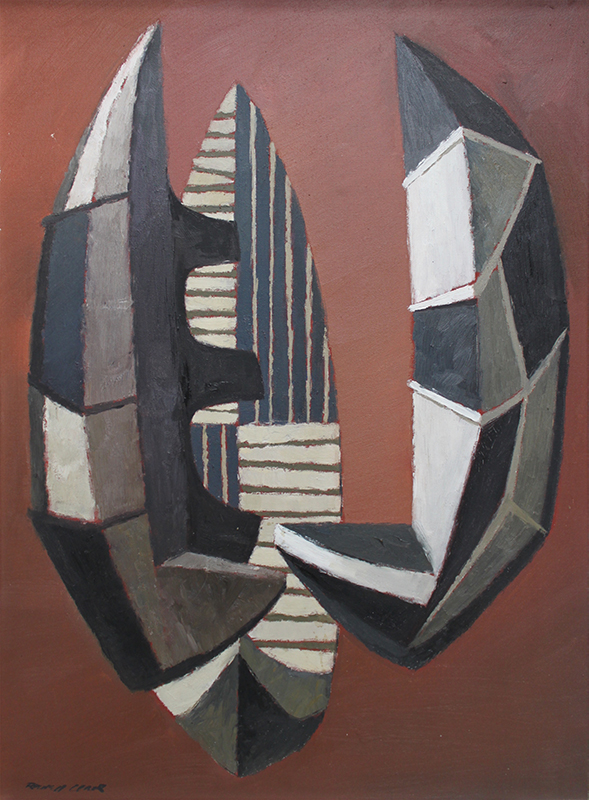
Russell Clark, Sculpture Group 4,1964, oil on canvas, Aigantighe Art Gallery Collection 1978.3
Russell Stuart Cedric Clark (1905–1966) was a man of many talents; a commercial artist, illustrator, painter, sculptor and university lecturer. Born in Christchurch on 27 August 1905, Russell Clark was the son of Mary Elizabeth Wyatt and her husband, William Clark, a plumber and tinsmith. At an early age Clark showed an interest in art, and was encouraged by his family to attend art school. From 1922 to 1927, Clark attended the Canterbury College School of Art. During this time he was taught by Leonard Booth, Richard Wallwork, Cecil Kelly, and Archibald Nicoll. Out of necessity Clark left art school in 1928 to work as a commercial artist for the Jewell–Skinner Advertising Agency. The following year he moved to Dunedin to take up a position as an illustrator for the printer and publisher John McIndoe. In 1932, he started evening and Saturday morning art classes at McIndoe’s design studio, which became popular with many younger Dunedin artists, including Doris Lusk and Colin McCahon.
After nine years in Dunedin Clark became uneasy and in 1938 moved to Wellington to work for the advertising agency Catts–Patterson. Then in 1941 he joined another Wellington advertising agency, Carlton–Carruthers. During his time in Wellington Clark became the principal illustrator for the New Zealand School Journal and The New Zealand Listener. It was through these two publications Clark became part of New Zealander’s everyday lives and became familiar to generations of school children for over twenty years.
With the outbreak of World War II Clark wanted to contribute to the war effort as a war artist and in 1942 approached the prime minister, Peter Fraser, offering his services. But it wasn’t until 1944 he was appointed Pacific War Artist by the New Zealand government. Clark was assigned to the 3rd New Zealand Division based mainly in the Solomon Islands. Over nine months he produced hundreds of sketches and painting of operations in the Pacific. Many of these sketches were later worked up into finished works in his Wellington studio.
When he returned to advertising in 1946, he was in his own words ‘unable to take it seriously’. Fortunately, he was successful in obtaining a teaching position at the Canterbury University College School of Art, which held until this death in 1966.
The 1950s was perhaps Clark’s most productive and experimental period with a focus on the distinctively New Zealand way of life. In particular a visit to Te Urewera in the central North Island for the School Journal provided new stimulus. His treatment of Maori in illustrations, painting and sculpture during this time had a naturalism that had rarely been achieved in New Zealand.
By the late 1950s, sculpture became Clark’s main focus and he was immersed in a series of large scale public sculptures. Among his noted public commissions were sculpture murals for the Timaru Telephone Exchange (1957) and the Christchurch International Airport (1959). These were heavily influenced by British sculptors Barbara Hepworth, Henry Moore and Lynn Chadwick.
Clark believed public sculpture was vital. He stated “it is important that the public should become used to outdoor sculpture and to accept it as they would any other seriously conceived decorative work”. He thought a small percentage of building costs should be allocated to public sculpture so cities can lose their “cultural starvation”.
Clark dedicated his life to art and became a force in New Zealand art in the middle of the twentieth century with unique images of New Zealand life and introduced modern public sculpture, changing attitudes toward art in public places.